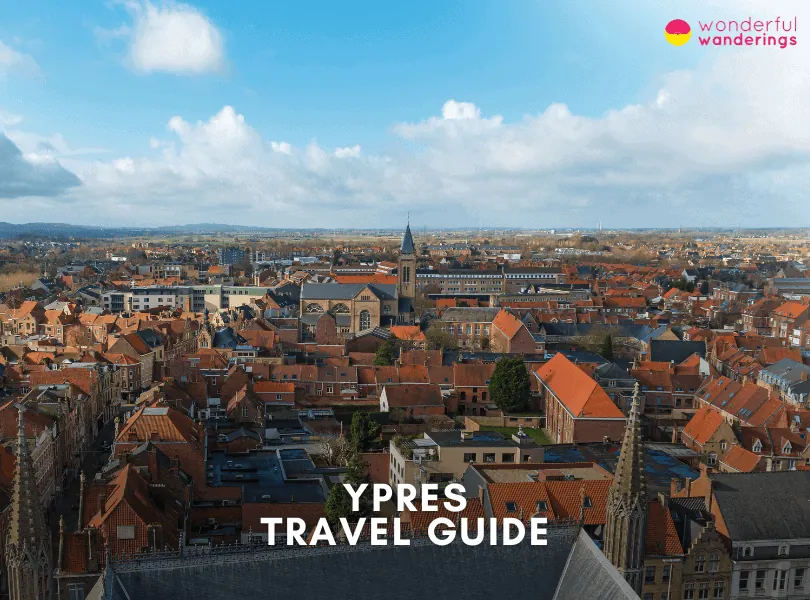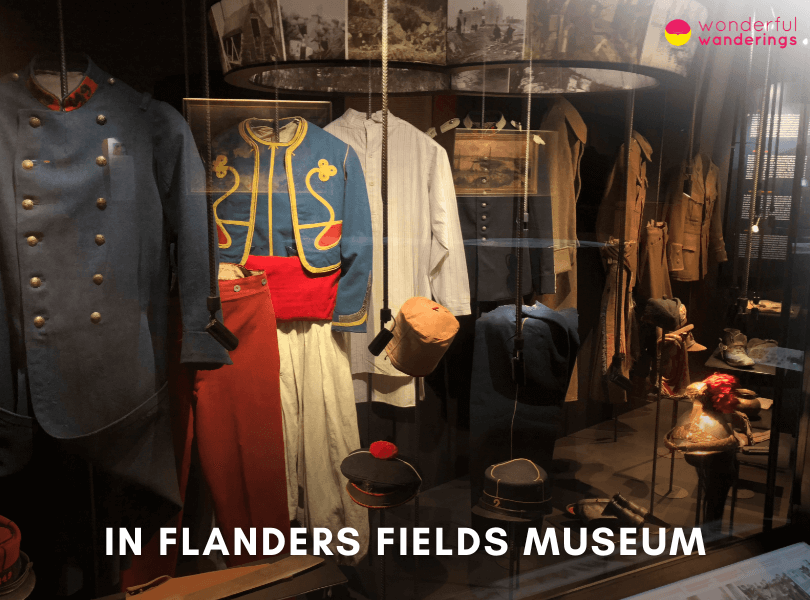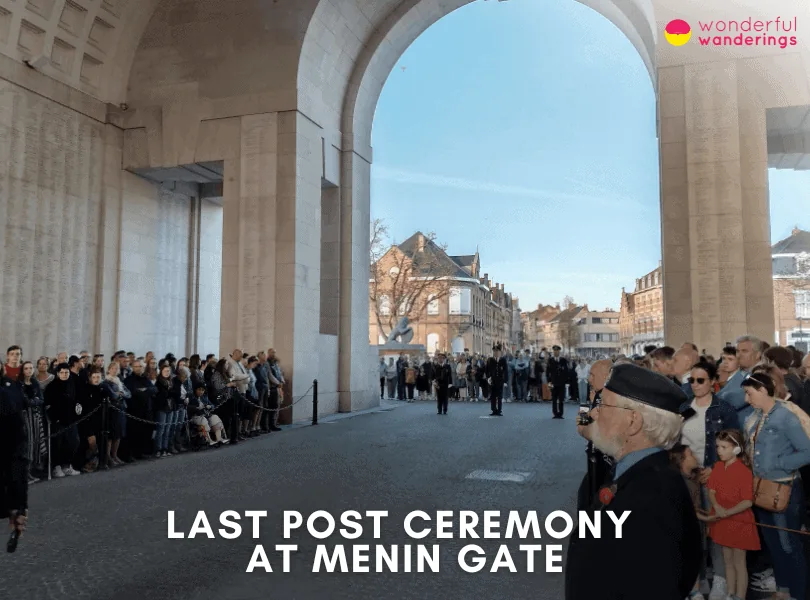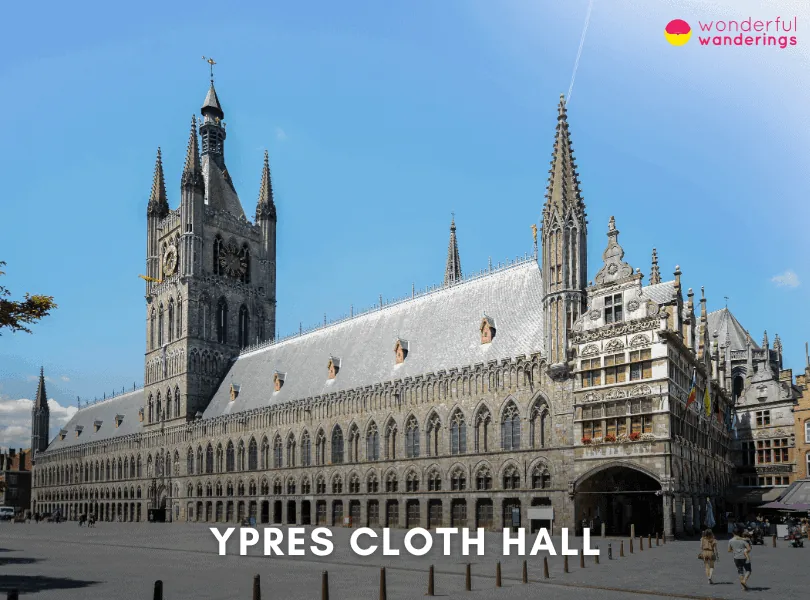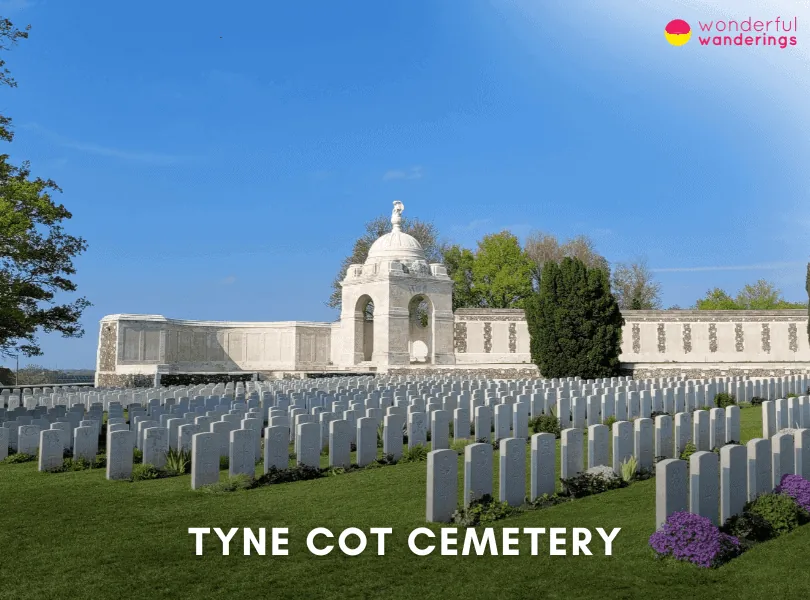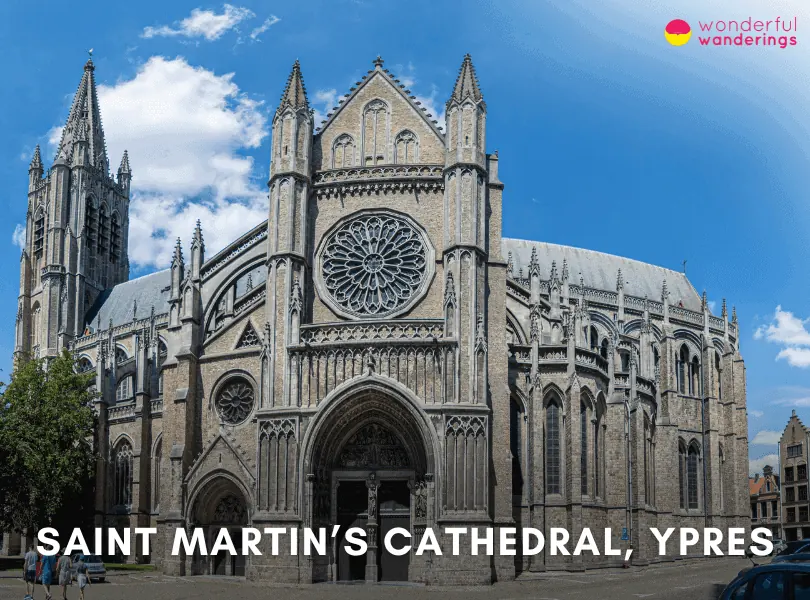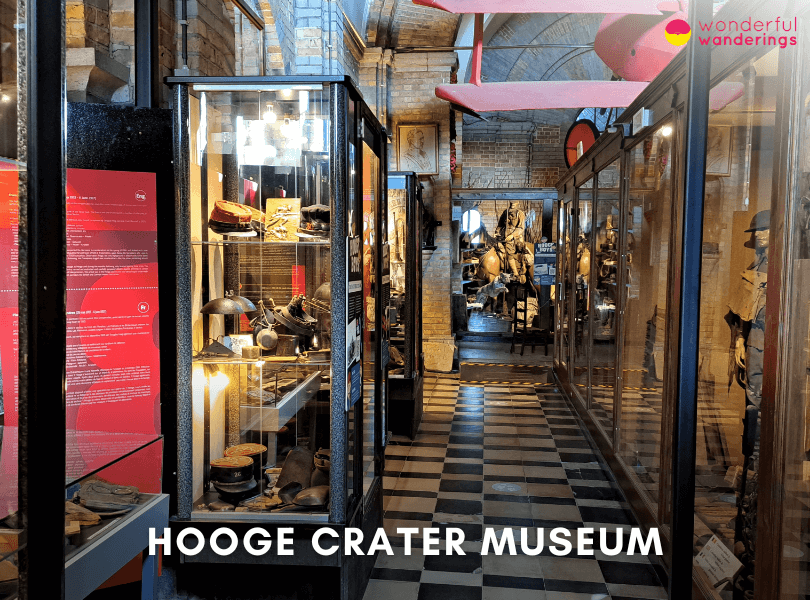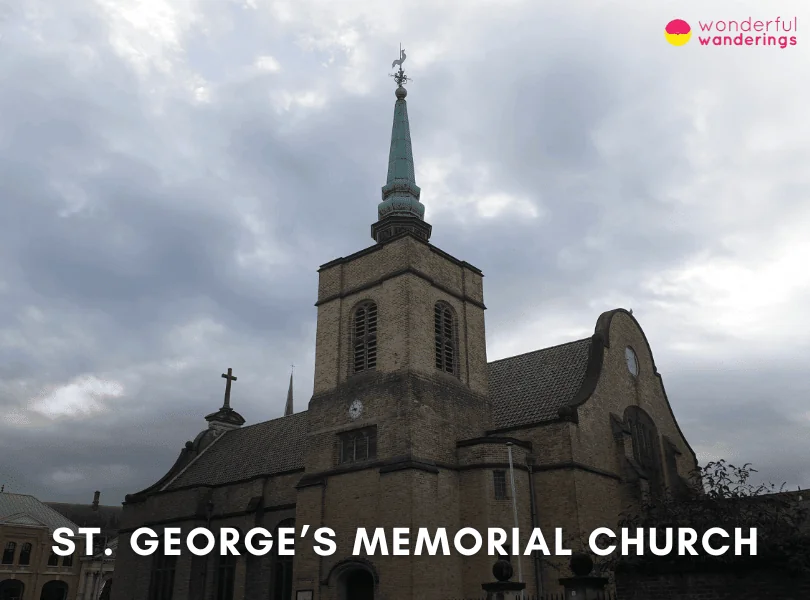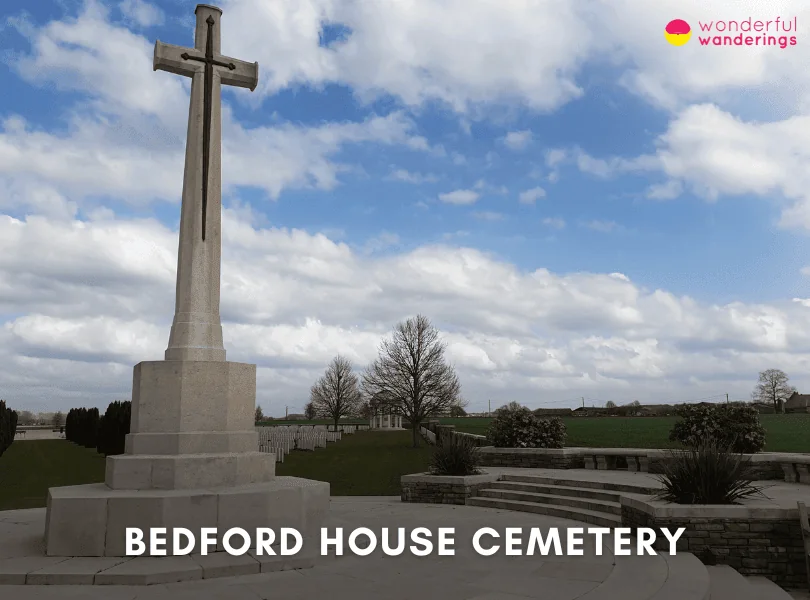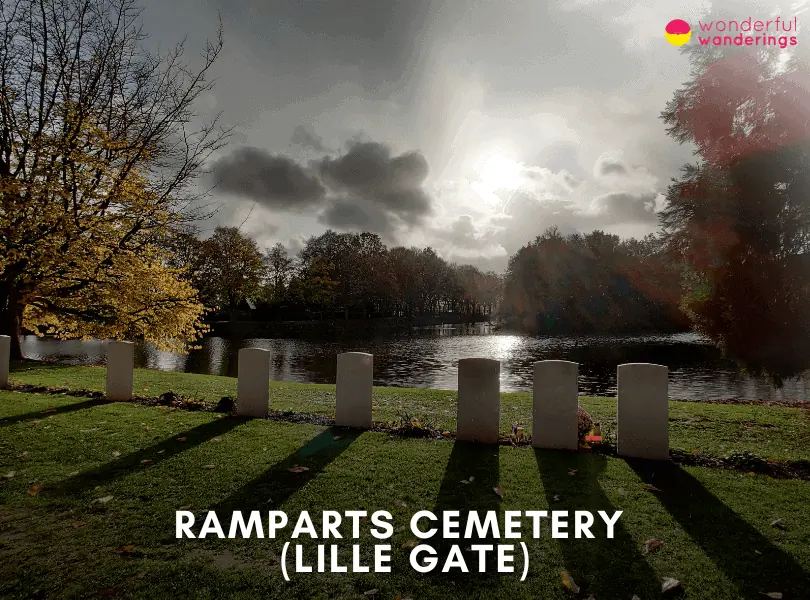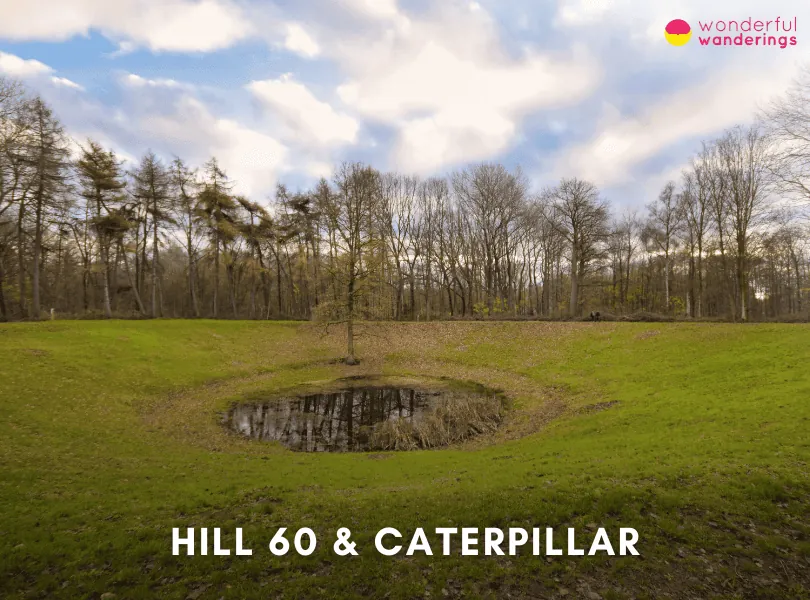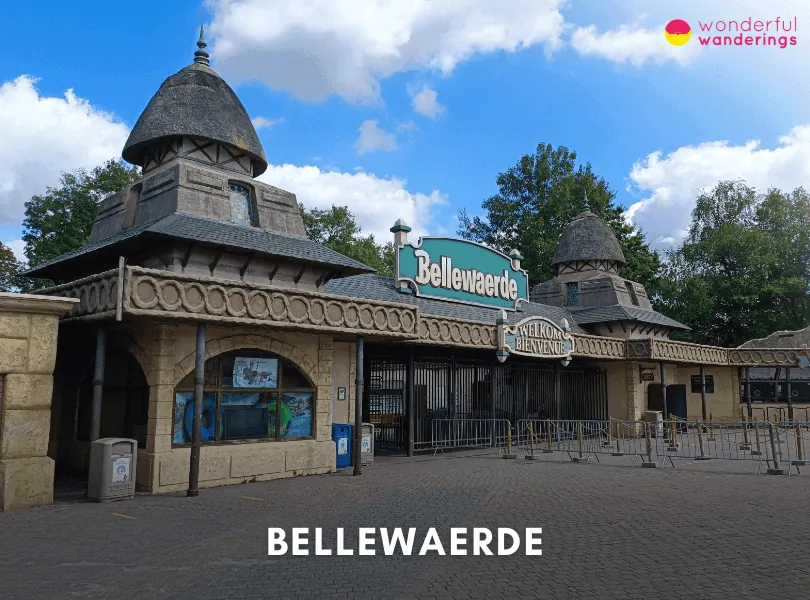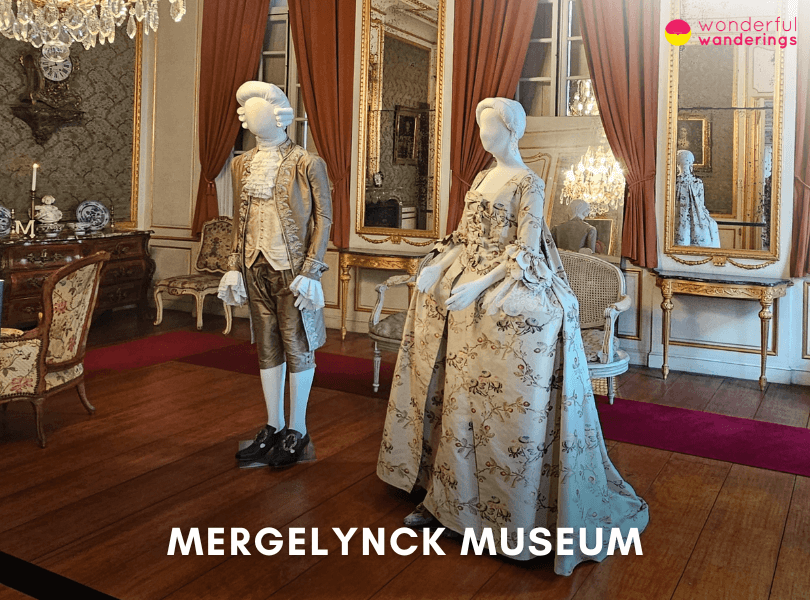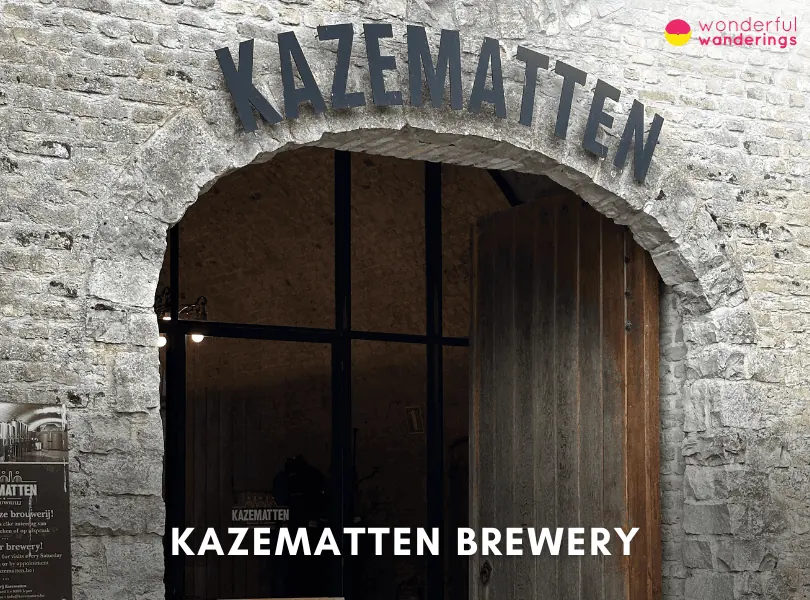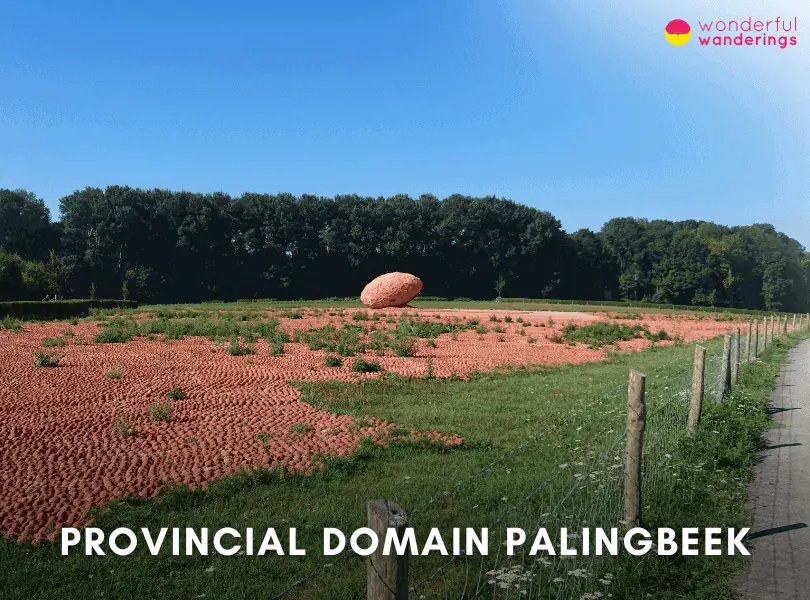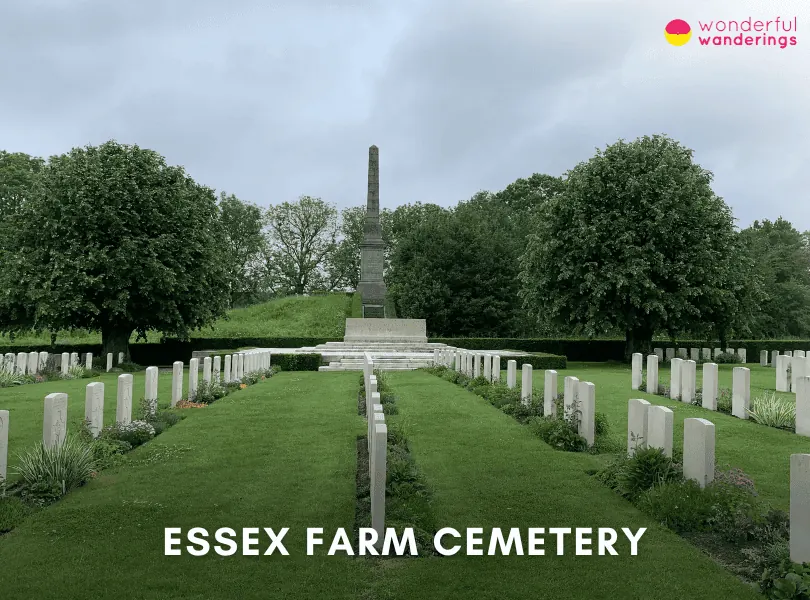Ypres stands as a living testament to a history steeped in valour, resilience and regeneration. Once a bustling hub of the cloth industry, Ypres witnessed significant turmoil during the Great Wars, only to rise again, showcasing an undying spirit that resonates with every visitor who graces its streets. As one embarks upon a journey to explore this remarkable city, a kaleidoscope of experiences awaits. The history of Ypres, vividly etched in its architectural marvels and commemorated in its memorials, beckons history enthusiasts and curious travellers alike. Ypres narrates tales of ancient times, where bustling markets thrived and the art of cloth making flourished. Embarking upon exploring the attractions in Ypres unfolds a journey through time. The solemn Menin Gate stands as a silent guardian, bearing the names of those who gave their lives in pursuing freedom during the First World War. Not far off, the In Flanders Fields Museum beckons with a promise of deeper insight into wartime experiences, offering a window into the past that is both moving and educational. Ypres doesn’t just dwell in the past, though. The vibrant Grote Markt square, lined with cafes and shops, offers a delightful juxtaposition of history and modernity, a place where one can soak in the present-day vigour of the city. As visitors traverse Ypres, the ease of transportation becomes evident. Ypres boasts a well-connected network of roads and railways, facilitating seamless journeys to and from various Belgian cities. Whether one travels by car or prefers the scenic views offered by train journeys, reaching Ypres and commuting within the city is a hassle-free experience. Ypres encourages eco-friendly transportation options, with numerous walking paths and cycling routes that allow one to explore the region leisurely, absorbing the richness of the surroundings at every turn.
Listed below are the things to do in Ypres.
- Visit the Flanders Fields Museum. The In Flanders Fields Museum teaches visitors about the human impact of WWI, especially in the Ypres Salient area. Visitors receive a poppy bracelet that activates multimedia displays telling stories of those who lived through the war. The museum features artifacts, films, visuals and soundscapes that provide an immersive and emotional experience, including hearing bombs and seeing gas seep into trenches. Visitors can climb a belfry with 231 steps for views over the rebuilt town and surrounding battlefield area that shows the utter destruction caused. A visit takes 1.5-2 hours to experience.
- Last Post Ceremony at Menin Gate. The Last Post ceremony takes place every evening at 8 pm under the Menin Gate Memorial. The ceremony pays tribute to over 54,000 British and Commonwealth soldiers who died in the Ypres Salient battle and have no known grave. The Last Post call is played, followed by a minute of silence. An excerpt from the poem “For the Fallen” is read before the Réveille bugle call signals the end. The ceremony takes 10 minutes and is popular which is why visitors are recommended to arrive to secure a good viewing spot.
- Ypres Cloth Hall. The Ypres Cloth Hall is one of the largest medieval commercial buildings in Europe. It houses the In Flanders Fields Museum, which is dedicated to World War I. The museum has interactive exhibits with artifacts, photos, recordings and more details on life in the trenches, individual soldier stories, battles around Ypres and reconstruction efforts after the war.
- Visit the Tyne Cot Cemetery. Tyne Cot Cemetery has 12,000 Commonwealth soldier graves and a memorial wall engraved with over 34,000 names. It serves as a solemn reminder of the loss of life during WWI’s Battle of Passchendaele. Visitors can pay respects while wandering through rows of graves, each marked “A soldier of the Great War – Known unto God”. The museum provides a moving and comprehensive look at what is known as the “war to end all wars”.
- Saint Martin’s Cathedral. Saint Martin’s Cathedral is a 102-meter-tall Gothic church that formerly served as the seat of the Diocese of Ypres. The church was heavily damaged in WWI and was rebuilt in the 1920s. Visitors can see the tombs inside of prominent figures like Cornelius Jansen, Bishop of Ypres and father of the Jansenism movement and Count Robert III of Flanders known as “The Lion of Flanders.
- Hooge Crater Museum. The Hooge Crater Museum has extensive World War I displays including uniforms, weapons, photos and trench recreations. Visitors can tour the museum, view films, explore preserved craters and trenches and visit the gift shop. It appeals to adults and children interested in history.
1. Visit the In Flanders Fields Museum
The In Flanders Fields Museum is located in the historic Cloth Hall building overlooking the Grote Markt (main market square) in the center of Ypres, Belgium. The museum is referred to as the Ypres Salient Memorial Museum. It was renamed after the famous poem “In Flanders Fields” by John McCrae.
The museum teaches visitors about the human impact and consequences of World War I, especially in the Ypres Salient area where war took place. Visitors receive a “poppy bracelet” that activates multimedia displays and stories of four individuals who lived through the war. The museum features artifacts, films, visuals and soundscapes that provide an immersive and often emotional experience. Visitors may hear bombs exploding in the distance or see gas seeping into trenches. Visitors can climb a belfry with 231 steps for views over the rebuilt town and surrounding battlefield area that shows the utter destruction caused. A visit takes 1.5-2 hours to experience. The museum is open daily, with an admission cost of €6 ($6, £5).
2. Last Post Ceremony at Menin Gate
The Last Post ceremony takes place every evening at 8 pm under the Menin Gate Memorial, located on the eastern side of Ypres. The Gate Memorial is a monument honoring over 54,000 British and Commonwealth soldiers who died in the Ypres Salient battle and have no known grave and their names are inscribed inside. The ceremony has taken place almost every night since 1928, until the German occupation in WWII. The ceremony resumed the evening after Ypres was liberated in 1944.
The Last Post call is played, followed by a minute of silence. An excerpt from the poem “For the Fallen” is read before the Réveille bugle call signals the end. The ceremony takes 10 minutes and is popular which is why visitors are recommended to arrive to secure a good viewing spot. There are hundreds of visitors, with the biggest crowds coming for the special 11 am ceremony on November 11 Armistice Day. It provides a haunting and emotional tribute to those who sacrificed their lives in one of the battle areas along the Western Front. It is a long-standing tradition cherished by locals and visitors alike.
3. Ypres Cloth Hall
The Ypres Cloth Hall, known as Lakenhalle in Dutch is a large cloth hall located at the Grote Markt (Market Square) in central Ypres. It is one of the largest commercial buildings from the Middle Ages and served as the main market and warehouse for Ypres’s prosperous medieval cloth industry. The original Cloth Hall was built in the 13th century but was destroyed during World War I. The current building is a reconstruction of the original hall that was completed in 1967.
Ypres Cloth Hall houses the award-winning In Flanders Fields Museum which is dedicated to commemorating the events and educating visitors about World War I. The museum features interactive exhibits with historical artifacts, documents, photographs, audio recordings and more. Some of the main attractions in the museum include exhibits on life in the trenches, stories from individual soldiers, details on the different battles that occurred around Ypres and information about the reconstruction efforts in Ypres after the war ended.
Visitors to the museum can take an audio tour, view short films and interact with touchscreen displays to learn about World War I history. The museum provides a moving and comprehensive look at what is known as the “war to end all wars”.
4. Visit Tyne Cot Cemetery
Tyne Cot Cemetery is the largest Commonwealth military cemetery in the world, located outside the Belgian village of Passchendaele. The cemetery has 12,000 graves of Commonwealth soldiers and a memorial wall engraved with over 34,000 names. Tyne Cot serves as a reminder of the loss of life during WWI’s Battle of Passchendaele.
Visitors to the site can pay their respects while wandering through row after row of mostly unnamed graves, each marked with the inscription “A soldier of the Great War – Known unto God”. The cemetery grounds contain pillboxes and other remnants of German defenses from 1917. The cemetery has a visitor’s center where wartime photographs and artifacts are displayed.
Tyne Cot Cemetery is open daily and admission is free. This cemetery provides visitors with a solemn place to reflect on the events of WWI and the consequences of war. This attraction is best suited for mature visitors. Visitors of all ages are welcome to pay their respects at Tyne Cot Cemetery.
5. Saint Martin’s Cathedral, Ypres
Saint Martin’s Cathedral, known as Sint-Maartenskathedraal, is a Gothic-style church and former cathedral located in the city center of Ypres, Belgium at Vandenpeereboomplein. It served as the cathedral and seat of the Diocese of Ypres from 1561 until 1801, when Ypres was incorporated into the Diocese of Ghent after the Concordat between Napoleon and Pope Pius VII. The church is 102 meters (335 feet) tall and is among the tallest buildings in Belgium.
Saint Martin’s Cathedral has gone through extensive damage and rebuilding over its history. The church was originally constructed between 1230 and 1370, was heavily damaged in World War I and was rebuilt from 1922 to 1930 based on the original Gothic architectural plans. Visitors can see the tombs inside of prominent figures like Cornelius Jansen, Bishop of Ypres and father of the Jansenism movement and Count Robert III of Flanders known as “The Lion of Flanders”.
Visitors can reach Saint Martin’s Cathedral by public transportation including bus or train to the Ypres town center. It is open to the public daily except during masses on Saturday evenings and Sunday mornings and evenings. There is no admission fee. It appeals to visitors of all ages interested in history, architecture, art and religion.
6. Hooge Crater Museum
The Hooge Crater Museum is a privately owned World War I museum located about 4 kilometers (2.4 miles) east of Ypres, Belgium on the Menin Road. The museum opened in 1994 in a restored 1920s chapel and features extensive displays relating to World War I in the area.
Hooge Crater Museum has a vast collection of original artifacts from World War I, including uniforms, weapons, equipment, photographs, documents and more. The museum has recreated trench warfare scenes with life-size displays and mannequins to give visitors an idea of what life was like for soldiers. The museum has a large piece of twisted railway track outside the museum entrance that was damaged during the war.
Visitors can tour through the museum exhibits at their own pace, watch short films about World War I and explore the nearby preserved outdoor crater sites and trenches. There is a small gift shop and thematic café onsite that serves food and refreshments. There are also clean toilet facilities available for visitors. The museum can be reached by local bus lines or visitors can drive, cycle or go on foot. It is perfect for adults and older children interested in history. Admission is €8.50 ($9.31, £7.71) for adults, with discounted rates for students and children under 18.
7. St. George’s Memorial Church
St. George’s Memorial Church is an Anglican church located at Elverdingsestraat 1 in central Ypres, Belgium. It was built as a memorial to over 500,000 British and Commonwealth soldiers who died fighting in the Ypres Salient battles during World War I and opened in 1929. The interior of the church serves as a tribute to the fallen soldiers with its plaques, flags, stained glass windows and furniture donated by various military regiments, schools and families.
St. George’s offers visitors a solemn and reflective environment to honor those who sacrificed their lives in WWI. Visitors can view the memorials, attend an ecumenical service, consult with the chaplain about the history of the war and cemeteries in the area or participate in annual Armistice Day events. The church is open daily, free of charge from 9:30 am until dusk. St. George Memorial Church welcomes visitors of all faiths and backgrounds who wish to pay their respects to the Commonwealth soldiers.
8. Bedford House Cemetery
Bedford House Cemetery is a Commonwealth War Graves Commission (CWGC) burial ground located about 2.5 kilometers (1.5 miles) south of central Ypres. It was established on the grounds of Château Rosendal, a country house that the British Army called “Bedford House” during World War I.
The cemetery contains over 5,100 World War I and II Commonwealth burials, including 3,000 unidentified soldiers. It comprises several enclosures divided by sections of the château’s former moats. Visitors can walk along the rows of headstones, read the inscriptions written and take in the overall atmosphere of remembrance and solemnity. The cemetery offers an opportunity to pay respects to the Commonwealth soldiers who were killed in the fight that took place in the Ypres Salient. Visitors of all ages and backgrounds can explore the burial grounds and reflect on the sacrifices made by so many young soldiers over a century ago. There is no admission fee to access the cemetery.
9. Ramparts Cemetery (Lille Gate)
Ramparts Cemetery (Lille Gate) is a small World War I cemetery located within the old ramparts of central Ypres, 1 kilometer (0.6 miles) South of the Grote Markt (Market Square) near the historic Lille Gate. It was first established by French troops in November 1914 and later used by Commonwealth forces until 1918. The cemetery contains 198 Commonwealth burials. The cemetery is located on the medieval stone walls overlooking the moat below.
Visitors can walk along the rows of headstones engraved with names and dates, honoring those who lost their lives during the war. Ramparts Cemetery offers an opportunity to reflect on the history that surrounds it while paying respects to the World War I soldiers. Its small size also lends the cemetery an intimate atmosphere compared to Ypres’ larger cemeteries. Ramparts Cemetery is publicly accessible daily to visitors of all backgrounds.
10. Hill 60 & Caterpillar
Hill 60 and the nearby Caterpillar are historic battlefield sites from World War I, located at the village of Zillebeke, 4 kilometers (2.5 miles) south of Ypres. Hill 60 is an artificial mound created from excavated soil and rubble during the construction of the railway line between Ypres and Comines in the 1850s. It was named Hill 60 by British forces on their trench maps since it stood 60 meters above sea level, giving it strategic importance. The Caterpillar is another mound formed from the railway work.
Both sites were captured by German forces in late 1914 during the First Battle of Ypres. Allied forces made several attempts to retake Hill 60, finally succeeding in 1917 after detonating multiple underground mines. The area is a battlefield that left the landscape filled with craters and trenches. Hill 60 was preserved by the Commonwealth War Graves Commission in its wartime state, with only some trees and grass growing over the decades. Craters, ruins of bunkers and traces of trenches can still be seen. Visitors can walk the grounds, view memorials and visit a preserved German bunker. The large Caterpillar crater is accessible nearby.
11. Bellewaerde
Bellewaerde is a theme park and zoo located at Meenseweg 497 in Ypres. The park originally opened in 1954 as a zoo and safari park called Toeristisch Centrum Bellewaerde (Tourist Centre Bellewaerde). The park has operated under several names over the years including Safari Bellewaerde and Bellewaerde Park before becoming Bellewaerde. The park occupies over 54 hectares near the grounds of a historic castle.
Visitors can enjoy rides and attractions which include world-class rollercoasters like Huracan, Boomerang and Dawson Duel, a variety of water rides including rapids and flume rides, a swinging pirate ship, vintage carousels and a madhouse haunted attraction. Safaris and zoo enclosures allow visitors to view exotic animals including elephants, giraffes, lions and tigers. The park features live entertainment and shows run during peak seasons. Bellewaered caters to 850,000 to 900,000 guests annually, making it the top theme park destination in Flanders. The park is open seasonally from April to October. Ticket prices start at €36 ($39, £31) for adults and €32 ($35, £27) for children.
12. Mergelynck Museum
The Merghelynck Museum is a cultural and historical museum located at Merghelynckstraat 2 in Ypres, Belgium. The museum is housed in a restored Baroque mansion built in 1774. The museum showcases the lifestyle of the nobility in the 18th century through its collection of artwork, porcelain, silverware and period furniture. Many artifacts on display were remnants from the original structure before it was destroyed in World War I and later reconstructed.
Visitors can explore the decorated rooms that feature French-style furnishings and admire the Chinese and Japanese porcelain collections. The museum also has an archaeological collection with over 800 medieval objects related to the cloth industry that made Ieper prosperous in the Middle Ages. It can only be visited by guided tour, which should be booked at least 2 weeks in advance. The museum is best suited for adults interested in history, art, architecture and antiques. Guided tours cost €70 ($76, £60) plus a €3.50 ($3.38, £3.03) entrance fee per person.
13. Kazematten Brewery
Kazematten Brewery is located at Houten Paard 1, 8900 Ypres, Belgium inside the 17th-century ramparts surrounding Ieper’s historic center. The name is from the casemates (“Kazematten” in Dutch) where the brewery is housed. British soldiers used these underground rooms to produce the satirical “Wipers Times” trench newspaper, which inspired the name of Kazematten’s signature blonde ale during World War I.
Visitors can tour and learn how the casemates have been used, from storing army provisions to serving as shelter and dormitories for troops defending Ieper during various sieges. Visitors can witness the compact brewhouse in action, see original brick vaults and stone walls and sample beers like the flagship Wipers Times, brewed with local ingredients including herbs grown along the ramparts. The brewery is open to the public every Saturday afternoon and tours need to be booked in advance for groups. It is best suited for beer lovers interested in history. Tours including tastings cost €12 ($13, £10)per person.
14. Provincial Domain Palingbeek
Provincial Domain Palingbeek is a 250-hectare nature park located in the Belgian city of Ypres, 6 kilometers (6.3 miles) to the Southeast. The park features woods, meadows, ponds and marshland along the route of the unfinished Ypres-Comines canal. Provincial Domain Palingbeek was a part of the frontline during the war and contains historical remnants such as bomb craters and Commonwealth cemeteries.
Visitors to Provincial Domain Palingbeek can walk or bike the 12.5 kilometers (7.7 miles) trail from the reception center. The route is marked with green Palingbeek hexagonal signs and passes remnants from World War I, including The Bluff, Hedge Row Trench Cemetery and Hill 60. Visitors can learn about the park’s history in the visitor center, observe the stars at the observatory, play in the playground, relax in the cafeteria or camp overnight. The park is free to enter and is open daily. The park is ideal for all visitors, including families, couples, individuals and groups.
15. Essex Farm Cemetery
Essex Farm Cemetery is a World War I cemetery located in Boezinge, Belgium, 2.5 kilometers (1.5 miles) North of Ypres along the Diksmuidseweg road. The cemetery was established in 1915 next to a British Army medical station and used as a burial ground until 1917. The cemetery contains the graves of over 1,200 Commonwealth soldiers killed in the Ypres Salient battles, including 103 unidentified soldiers.
Essex Farm Cemetery is associated with Canadian Army doctor John McCrae, who wrote the famous wartime poem “In Flanders Fields” in May 1915 after presiding over the funeral of his friend. Visitors can stroll through the rows of headstones, read the names of soldiers, reflect on the history and view the remaining bunkers. The cemetery grounds are accessible year-round. Essex Farm Cemetery appeals to history-minded adults and older children can appreciate its significance if adequately prepared for the heavy subject matter around war and loss that the location represents. The cemetery does not charge any entrance fees.
Where is Ypres?
Ypres is a city located in western Belgium. It was the scene of several important battles during World War I, located on the Western Front. The British Expeditionary Force clashed with the German Army in the First Battle of Ypres in October and November 1914. There were two more significant battles in Ypres during the war – the Second Battle of Ypres in 1915, which saw the first use of poison gas on the Western Front and the Third Battle of Ypres in 1917, also known as the Battle of Passchendaele, which resulted in enormous casualties for both sides due to the muddy terrain. Throughout the war, Ypres occupied an important strategic position. It served as a bastion for the Allies to try and prevent the Germans from advancing west towards the French ports on the English Channel. Today, Ypres remains an essential symbol of the horrors of trench warfare during World War I.
What is the history of Ypres?
Ypres is a city in western Belgium that has a long history but is most famous for its role in World War I. Located near the border with France, Ypres dates back to the 11th century and grew as a centre of the cloth trade. It was fortified with massive walls and gates, remnants still standing today. In the 16th and 17th centuries, under Spanish rule, Ypres continued to prosper but declined in the 18th century under the Austrians. Ypres occupied a strategic location on the Western Front during World War I. It was the site of intense fighting as both sides tried to capture the high ground around the city. The British Expeditionary Force successfully repelled German attacks on Ypres in 1914 during the First Battle of Ypres. In 1915, the Second Battle of Ypres saw the first use of poison gas as a weapon on the Western Front. The Third Battle of Ypres 1917, also known as Passchendaele, infamously saw hundreds of thousands of casualties in the mud-soaked terrain. After the war, Ypres was reconstructed to its glory and today, it is remembered for its courage and sacrifice as a symbol of the horrors of the Great War. The Menin Gate memorial in Ypres contains thousands of names of British and Commonwealth soldiers killed in Belgium with no known graves.
What language is spoken in Ypres?
The main language spoken in Ypres itself is Dutch. Ypres is located in the Dutch-speaking region of Flanders in Belgium. Specifically, most people in Ypres speak a dialect of Dutch called West Flemish. This is common throughout the West Flanders province that Ypres is located in. West Flemish’s phonology and vocabulary differ somewhat from the standard Dutch spoken as an official language in Belgium. Many people in Ypres also speak French, the other official language of Belgium and English, used for international communication. But when locals communicate with each other in Ypres and surrounding towns, they generally use West Flemish rather than French. The historic centre of Ypres is called the Lakenhalle and all the information signs, menus and announcements there are in Dutch. So, for visitors who only speak English and French, West Flemish-speaking Ypres can present a bit of a language barrier compared to some other major cities in Belgium that are more French-speaking.
What timezone is Ypres on?
Ypres is in the Central European Time zone, UTC+1. This means it is 1 hour ahead of Coordinated Universal Time. As Ypres is located in western Belgium, it uses Central European Time like the rest of the country. This timezone spans from Portugal in the west to Poland in the east and is the most widely observed timezone in the European Union. Countries like France, Germany, Italy and Spain are also on Central European Time. The UK, meanwhile, is 1 hour behind Ypres in the Western European Time zone at UTC+0. Central European time is used in Belgium all year round – there is no daylight saving time change, unlike in the UK. So, during the winter, Ypres remains 1 hour ahead of places like London. During the summer, when the UK has moved its clocks forward 1 hour, Ypres is 2 hours ahead until the end of British Summer Time. In summary, the consistent year-round timezone used in Ypres and elsewhere in Belgium is Central European Time, which usually is 1 hour ahead of the UK.
How many people live in Ypres?
Ypres is a medium-sized city in Belgium with 36,005 people. Most people, 26,219, are adults between 0 and 59 years. There are 18,130 females and 17,875 males. Ypres also has a significant elderly population, with 9,748 residents aged 60 years or older. Many of these older residents live in retirement homes and assisted living facilities around the city. The town has several schools at the primary and secondary levels, which cater to local families. Overall, Ypres has a typical demographic spread for a historic city of its size in Belgium. The population mixes older lifelong residents, younger professionals and families attracted to living in a peaceful provincial town with a rich history. Tourism connected to World War I sites also employs many locals in Ypres, supporting the economy.
What are the most interesting facts of Ypres?
Listed below are the most interesting facts of Ypres.
- Ypres Currency. In Ypres, as is the case throughout Belgium, the official currency utilised is the Euro (€), denoted as EUR. This facet allows for ease of financial transactions, especially for tourists coming from the Eurozone, as they don’t need to worry about currency exchange. Moreover, having a uniform currency promotes economic stability and facilitates trade with other European nations, thereby contributing to the broader economy.
- Timezone of Ypres. The timezone that Ypres adheres to is Central European Time (CET) during the standard period and Central European Summer Time (CEST) during the daylight saving time, which is typically from the last Sunday in March to the last Sunday in October. This time setting is synchronised with many other European countries, making it convenient for international relations and travel planning. Recognising the timezone is pivotal for travellers and is integral to the foundation.
- The Primary Language in Ypres. The primary language spoken in Ypres is Dutch, specifically the West Flemish variant of the Dutch language. While French and German are also official languages in Belgium, the populace of Ypres predominantly communicate in Dutch. This linguistic preference is a testament to the region’s historical and cultural affiliations and understanding this can significantly enhance one’s experience while visiting, as it is tied to the larger linguistic.
- Power Plugs Used. The power plugs and sockets used in Ypres are of type E. The standard voltage is 230 V and the expected frequency is 50 Hz. This information is vital for tourists to ensure the compatibility of their electronic devices during their stay. Equipping oneself with knowledge about the type of power plugs used forms a necessary and practical part of the facts of Belgium, facilitating a smooth and hassle-free travel experience.
What is Ypres famous for?
Ypres is most famous for its pivotal role in World War I as the site of numerous significant battles on the Western Front. Although Ypres was first established in the 11th century and has a long history as a prosperous cloth trading centre, its association with World War I dominates the modern memory of the city. Between 1914 and 1918, the British Expeditionary Force, French army and German army were locked in bitter fighting for control of Ypres and the strategically important high ground surrounding the city. There were three major battles at Ypres during the war, which saw massive casualties from trench warfare and shelling. The Second Battle of Ypres in 1915 also infamously saw the first use of chemical weapons on the Western Front. Today, Ypres is known internationally as a memorial site for the sacrifice and horrors of the Great War. Hundreds of thousands of war dead are buried in cemeteries and memorials around Ypres, which draws many visitors interested in World War I history. While Ypres was painstakingly rebuilt after the war and still has a beautiful town centre, its identity will forever be linked to the bloody fighting that engulfed the area during World War I. For this reason, Ypres is regarded as one of the most significant and symbolic World War I battle sites.
What to do in Ypres for a day?
Listed below are what to do things in Ypres for a day:
- Visit The Menin Gate. Starting one’s journey early in the morning, a visitor can embrace the solemnity that the Menin Gate brings forth. This prominent war memorial, engraved with the names of thousands of soldiers who perished in the First World War, serves as a poignant reminder of the region’s turbulent past. In just a day, an individual can take time to participate in the daily Last Post ceremony held at 8 p.m. This tradition has endured for nearly a century, echoing the respect and memory of the brave souls who fought during the conflict.
- Explore the In Flanders Fields Museum. As one continues their 24-hour sojourn in Ypres, stopping at the In Flanders Fields Museum around mid-morning would be a vital addition to the itinerary. Located in the historic Cloth Hall, the museum presents an interactive and engaging exhibition that depicts the harsh realities of the First World War. Here, individuals can immerse themselves in personal stories, artefacts and multimedia displays that narrate the devastating impacts and the human stories intertwined with the war.
- Stroll around The Grote Markt. Venturing towards the city’s vibrant heart, the Grote Markt would be an excellent way to spend the early afternoon hours. The central square is surrounded by beautiful buildings and various cafes where one can enjoy a delightful Belgian lunch. Being a hub of activity, it offers a pleasant contrast to the morning’s historical exploration, allowing individuals to soak in the vibrant atmosphere and perhaps indulge in some shopping or simply enjoy a relaxed stroll.
- Take a Walk along the Vauban Ramparts. In the late afternoon, one might find tranquillity by taking a leisurely walk along the Vauban Ramparts. These historical fortifications offer a glimpse into the strategic importance of Ypres in the past. Moreover, the lush green surroundings provide a serene backdrop for a peaceful walk, where one can reflect on the rich tapestry of experiences they’ve encountered throughout the day in Ypres.
- End the day at the Kazematten Brewery. As the evening approaches, rounding off the 24 hours in Ypres with a visit to the Kazematten Brewery can offer a delightful ending. Located within the historic ramparts, the brewery offers a unique blend of history and modern craft beer culture. Here, one can sample some of the finest Belgian beers, perhaps accompanied by a hearty dinner, bringing a fulfilling closure to a day well spent exploring the multifaceted city of Ypres.
What is the ideal visit duration for a Ypres visit?
The ideal visit duration for a trip to Ypres is between 2 and 3 days. Given Ypres’s rich historical and cultural fabric, dedicating just one day would undoubtedly offer a glimpse into the city’s heritage and main attractions; however, it might take time. Allocating a visit duration of 2 to 3 days would permit a more leisurely exploration of the city’s significant landmarks and attractions, allowing for a deeper understanding and appreciation of the place. During a multi-day stay, visitors can delve deeply into the historical significance of areas such as the Menin Gate, the In Flanders Fields Museum and various World War I battlefields that bear silent testimony to the brutal conflicts that once ravaged this region. Moreover, a stay of this length allows for exploring Ypres’s natural beauty and architectural splendour, including strolls along the Vauban Ramparts and indulging in the culinary delights that the local restaurants serve. Furthermore, extending the visit duration beyond one day allows visitors to immerse themselves in the local culture, possibly attending some of the vibrant events often held in the Grote Markt, the city’s central square. This additional time offers the possibility to truly absorb this historic city’s serene yet vibrant atmosphere, mingling with locals and perhaps enjoying a leisurely cup of coffee in one of the many quaint cafes dotting the area. Therefore, when pondering on “how long to spend in Ypres”, it is advisable to plan a visit that spans a couple of days, thereby allowing for a balanced blend of historical exploration and relaxed enjoyment of the city’s present-day offerings, making the trip both enlightening and rejuvenating.
What Belgian food should someone eat in Ypres?
Ypres offers visitors an excellent opportunity to sample delicious local cuisine from the West Flanders region of Belgium. As a historic city, some traditional Belgian dishes to try in Ypres are stewed meatballs in Gueuze beer called Gueuzeballetjes, rabbit cooked in Westvleteren beer known as Konijn in Westvleteren and Flemish carbonade beef stew made with beer and mustard. The city is also famous for its cheese, in particular, a semi-soft cheese called Passendale after the World War I battle site nearby. Beer fans should sample the excellent Abbey and Trappist beers produced at monasteries around Ypres, including the distinctive Westvleteren blonde and dark beers, which are difficult to find outside Belgium. Those with a sweet tooth can enjoy Belgian waffles, pancakes and French fries topped with mayonnaise or unique sauces. As Ypres is located in Flanders near the border with France, the cuisine shows both French and Dutch influences. Overall, visitors will find a tasty blend of local specialities and high-quality cuisine in Ypres that reflects the rich cultural heritage of food in Belgium.
What are the best restaurants to eat in Ypres?
There are a 5 best restaurants to eat in Ypres. Firstly, with “De Heerlyckheid”, this establishment is a haven for food enthusiasts seeking to enjoy a luxurious dinner with an exquisite assortment of delightful and expertly crafted dishes. Their menu boasts a fine selection, warranting reservations in advance to secure a seat at this sought-after location. Secondly, “Ypresburger”, caters to individuals with a penchant for gourmet burgers. Offering both lunch and dinner options, it presents an exciting twist to the classic burger experience, making it a favourite spot for locals and tourists alike. Thirdly, “A L’Envers” is another establishment that beckons visitors with its enticing menu options. This place is perfect for a leisurely lunch where one can savour a range of delectable dishes crafted with a touch of culinary innovation, promising a satisfying and memorable meal. Fourthly, the “Restaurant Découverte” is where one can experience culinary finesse at its best. Ideal for dinner, this restaurant offers a sophisticated dining experience with a diverse and intriguing menu, inviting diners to explore a world of flavours that are sure to tantalise the taste buds. Lastly, the “Hostellerie Saint Nicolas” is a beacon of culinary excellence in Ypres. Known for its impeccable service and fine dining options, it is a place where one can enjoy a lavish lunch or dinner, complete with a tranquil ambience that complements the exquisite food offerings.
Listed below are the best restaurants to eat in Ypres.
- De Heerlyckheid. Located in a charming 4-star hotel, this relaxed yet elegant restaurant serves refined traditional Flemish cuisine, like beef stew, rabbit in beer sauce, and shrimp croquettes. Extensive wine list and peaceful courtyard dining available.
- Ypresburger. This casual spot just outside central Ypres specialises in homemade burgers at affordable prices. Also offers Belgian fare like fries, meatballs and mussels. No-frills setting but generous portions and friendly service.
- A L’Envers. Intimate gourmet restaurant in central Ypres serving creative French-Belgian tasting menus with local ingredients. Dishes may include shrimp with tomato foam or Flemish beef cheek in beer. Book well ahead to secure one of 16 seats.
- Restaurant Découverte. Elegant converted farmhouse near Ypres blending French cuisine with Belgian hospitality. Seasonal menu stars regional fare like pan-seared duck foie gras, herb-crusted lamb and white asparagus. Superb but pricey.
- Hostellerie Saint Nicolas. Michelin-starred French-Belgian cuisine served in a beautifully restored 18th-century farmstead turned small luxury hotel. Reservations essential to savour the refined regional tasting menus and wine pairings.
1. De Heerlyckheid
De Heerlyckheid is an elegant yet informal restaurant located right inside the charming 4-star De Heerlyckheid Hotel in central Ypres. Housed in an 18th-century former convent, the restaurant’s atmosphere perfectly matches the historic setting. The menu features refined updates of traditional regional cuisine using fresh local ingredients. Dishes may include Flemish beef stew, rabbit in Westvleteren beer sauce or North Sea shrimp croquettes. An extensive wine list offers fine Belgian and French vintages. Weather permitting, request a table on the peaceful courtyard terrace tucked away from the street. Attentive service and reasonable prices for the high quality complete the experience. De Heerlyckheid makes a sophisticated but relaxed choice for a special night out while visiting Ypres. The central location also makes stopping in for lunch or afternoon coffee easy. Reservations are recommended as it’s popular with hotel guests and local diners. For an elegant meal showcasing the best of Flemish cooking in a historical setting, De Heerlyckheid is undoubtedly one of Ypres’ top dining destinations.
2. Ypresburger
The Ypresburger is a casual restaurant located just outside Ypres’ historic centre that specialises in – as the name suggests – burgers. Ypresburger modest local spot offers diners a selection of juicy homemade beef, chicken and vegetarian burgers at affordable prices. The menu also includes typical Belgian fare like fries, meatballs, mussels and a range of Belgian beers. The simple, no-frills setting features wooden tables and a bar area for single diners. While not fancy, portions are generous and service is fast and friendly. The Ypresburger makes an easygoing option for lunch or dinner after a day of sightseeing in Ypres. It’s popular with tourists staying at the nearby Ypresburger budget hotel. Reservations are optional but can be a good idea on weekends when it gets busy. While more upscale restaurants are abundant in central Ypres, the Ypresburger is a reliable choice for casual local fare and an authentic Belgian burger experience. The Ypresburger provides good value for money without breaking the budget.
3. A L’Envers
A L’Envers is an intimate gourmet restaurant in the heart of Ypres’ historic city centre. Housed in a beautifully restored 16th-century building, it blends historic charm with a contemporary fine dining experience. A L’Envers serves a seasonal tasting menu that skillfully incorporates local ingredients into creative French-inspired cuisine. Dishes may include delights like West Flanders shrimp with tomato foam, Flemish beef cheek slow-cooked in beer and Belgian chocolate mousse with hazelnut crumble. The dining room only seats 16 people, so book reservations well in advance. Knowledgeable waitstaff provides excellent personalised service to guide you through the culinary experience. While not cheap, a meal at A L’Envers offers exceptional quality and memorable flavours you won’t find elsewhere in Ypres. With its central location near sights like the Cloth Hall and St. Martin’s Cathedral, visiting A L’Envers for a refined dinner after a day exploring Ypres’ Gothic architecture and World War I sites is easy. The intimate ambience also makes it a popular choice for a romantic meal.
4. Restaurant Découverte
Restaurant Découverte is an elegant French-Belgian restaurant just outside Ypres’ town centre—the rustic-chic interior features exposed beams, brick walls and a cosy fireplace in a converted farmhouse. The menu changes seasonally to highlight the best local ingredients from West Flanders. Dishes may include indulgences like pan-seared duck foie gras, herb-crusted rack of lamb or white asparagus with hollandaise sauce. Extensive wine pairings are available. Reservations are essential as Restaurant Découverte only seats around 35 diners to provide personalised service. Restaurant Découverte is a place to take your time enjoying a special romantic meal or event. While not cheap, the culinary creativity and flawless execution make it worthwhile for foodies. The knowledgeable waitstaff is happy to explain all the details of each dish and wine. With a 30-minute walk or short drive from central Ypres, Restaurant Découverte makes a first-rate splurge for those seeking fine dining in an intimate setting surrounded by nature. Restaurant Découverte is the perfect blend of French cuisine, Belgian hospitality and Flemish charm.
5. Hostellerie Saint Nicolas
Hostellerie Saint Nicolas is an upscale restaurant with rooms located just outside central Ypres in the village of Zillebeke. Housed in a beautifully restored 18th-century farmstead, the rustic-chic dining room features vintage tiles, antique furniture and a cosy fireplace. Hostellerie Saint Nicolas specialises in refined French-Belgian cuisine using premium regional ingredients. The seasonal menu may include pan-seared scallops, confit duck leg or Belgian chocolate soufflé. Extensive wine pairings are available. The small dining room seats just 50 people, so reservations are essential. Dinners are leisurely, lasting 2-3 hours to fully savour each course. For immersive indulgence, staying in one of the 14 elegant rooms allows you to retreat to the peaceful countryside after dining. While relatively expensive, Hostellerie Saint Nicolas offers a Michelin-starred culinary experience in an idyllic setting. The 10-minute drive from Ypres makes it an ideal particular occasion restaurant after a day of sightseeing. Hostellerie Saint Nicolas is a true destination for pleasing dining devotees visiting Flanders.
What are the best areas to stay in Ypres?
Listed below are the best neighbourhoods to stay in Ypres.
- City Centre. The city centre is one of the prime neighbourhoods to consider while contemplating where to stay in Ypres. The City Centre area grants visitors immediate access to various attractions and historical sites, making it a convenient location for those keen on exploring the city’s heart. Furthermore, its vibrant atmosphere offers a genuine taste of the local culture and traditions.
- Stationsbuurt. Stationsbuurt is another desirable neighbourhood to mark on one’s list. This well-connected area offers easy access to the city’s public transport hubs. Its proximity to the railway station makes it a strategic location for those planning to explore other parts of Belgium while enjoying the peaceful environment that this neighbourhood offers.
- Sint-Jan. The Sint-Jan neighbourhood is known for its tranquil environment, making it an excellent choice for those seeking a quiet retreat not far from the bustling city centre. This area offers a range of accommodation options, ranging from luxury hotels to cosy bed and breakfast establishments, providing a range of choices to suit various preferences and budgets.
- Rijselstraat. The Rijselstraat area offers a blend of residential and commercial spaces, providing a balanced atmosphere for visitors. This neighbourhood is dotted with various eateries and shops, providing an excellent opportunity for those keen on indulging in local culinary delights and shopping experiences. Its relative proximity to the city centre also means that guests staying in this area can easily venture to the heart of Ypres for a more comprehensive exploration of what the city offers.
What are the best hotels to stay in Ypres?
Listed below are the best hotels to stay in Ypres.
- Main Street Hotel. Main Street Hotel stands as a beacon of luxury in the heart of Ypres, offering its guests an impeccable blend of modern amenities and traditional charm. Each facet of this establishment speaks volumes about its commitment to providing a comfortable and memorable stay. A visit to Main Street Hotel guarantees an indulgence in luxury, complemented by an exquisite dining experience that promises to cater to the culinary desires of its guests.
- Hotel Ambrosia. The Hotel Ambrosia is a place where warmth and hospitality take centre stage. This establishment, known for its inviting atmosphere, ensures every guest finds a home away from home. The rooms at Hotel Ambrosia are a testament to its dedication to providing a tranquil retreat, fostering a harmonious balance between comfort and luxury, thereby ensuring an enriching stay that resonates well with travellers from all walks of life.
- Hotel Ariane. The Hotel Ariane is distinguished in Ypres’ vibrant hospitality sector. This hotel epitomises elegance and refinement, promising a vacation that is nothing short of luxurious. A stay at Hotel Ariane means stepping into a world of elegance and comfort, where every detail is curated to offer an experience that is both exclusive and refined, making it a favoured choice for those seeking to experience one of the best hotels in Ypres.
What is the transportation like in Ypres?
Transportation in Ypres is entirely developed and facilitates easy movement within and outside the city. The city has a well-organised network of local buses that connects various parts of Ypres, making it quite convenient for residents and visitors to travel around. The roads in and around Ypres are well maintained, making car journeys a smooth experience. Additionally, cycling is a popular mode of transport in the city, with many cycle paths available for enthusiasts. For those contemplating long-distance travel to and from the town, mentioning the train services between “Brussels and Ypres” is noteworthy. The trains provide a comfortable and efficient means of travelling the approximately 120 km (74.6 miles) distance between the two cities, usually with a transfer at a significant junction, offering travellers a chance to witness the beautiful landscapes of Belgium. Furthermore, when considering how to get to Ypres from London,one has several options. The most common is taking a train from London to Brussels and then another from Brussels to Ypres. This journey offers a seamless transportation experience, allowing travellers to transition smoothly between the UK and Belgium whilst enjoying the scenic vistas that grace the route. The connection from “Bruges to Ypres” is also relatively straightforward, with regular train services between the two cities. The journey, covering a distance of approximately 53 km (32.93 miles), is relatively quick and offers a convenient way to travel between the two popular Belgian destinations.
How to get from Ypres to Brussels?
Listed below are steps on how to get from Ypres to Brussels:
- Firstly, one should start by carefully planning their journey from Ypres to Brussels, taking into consideration the time and day of travel. Gathering all necessary belongings, including personal identification and travel documents, is essential.
- Secondly, they should ensure that they have a reliable GPS or a map to assist them in navigating the route with ease. It might be helpful to familiarise oneself with the way beforehand to avoid delays.
- Thirdly, one must initiate their journey by heading to the city centre of Ypres. This location serves as a prime point to access various modes of transportation that lead to Brussels.
- Fourthly, if they opt to travel by train, they must proceed to the Ieper train station. It is recommended to appropriately check the train schedules to time their arrival at the station.
- Fifthly, they must purchase tickets to Brussels upon reaching the train station. Buying tickets from the ticket counter or through digital platforms is possible to avoid queues.
- Sixthly, they should board the train and settle in for the journey. It is important to note that the train journey might require a transfer at a significant junction, most likely at Gent-Sint-Pieters station, where they will find trains connecting to Brussels.
- Alternatively, if one chooses to drive to Brussels, the seventh step involves securing a car, either their own or a rental. Ensuring the vehicle is in good condition and fuelled up is essential before starting the journey.
- Eighth, they initiate the car journey, adhering to the directions provided by the GPS or map. Generally, the route involves getting onto the A19 motorway, which connects Ypres directly to Brussels.
- Ninth, they should drive safely, respecting the traffic rules and regulations in Belgium. They can enjoy the scenic Belgian landscape along the route, taking periodic breaks to stay refreshed.
- Lastly, upon reaching the destination, they need to find a safe and legal parking space if they travel by car. Those who travelled by train should disembark and begin their exploration of Brussels, possibly using local transport to get around the city.
Are Christmas markets crowded in Ypres?
Yes, the Christmas markets in Ypres are indeed crowded. Many individuals flock to the region to partake in the festive cheer in the Christmas season. The markets in Ypres during this season are characterised by a lively and bustling atmosphere. Locals and tourists, throng the streets to enjoy the festive offerings available during this period. Many stalls offering various products and delicacies also attract people from multiple places. The vibrant atmosphere is further amplified by the variety of entertainment options available, which generally draws a considerable crowd. Ypres Christmas markets are indeed a magnet for groups, with many individuals seeking to immerse themselves in the festive spirit that pervades the streets of Ypres during this time of the year. This considerable influx of people contributes to a crowded but festive environment, making the Ypres Christmas markets a bustling hub of activity and joy.
What are the most visited Christmas markets in Belgium?
Listed below are the most visited Christmas markets in Belgium:
- Brussels Winter Wonders. Brussels Winter Wonders is one of Belgium’s largest and most visited Christmas markets in the heart of Brussels. It features over 200 chalets, a grand ice rink and a mesmerising sound and light show at the Grand Place.
- Bruges Christmas Market. Bruges Christmas Market is set in Bruges. This market offers a fairy-tale setting with its cobbled streets and historic buildings. It’s particularly famous for its ice sculpture festival and the variety of handmade crafts available.
- Ghent Christmas Market. Ghent Christmas Market is located in the historic city of Ghent; this market is known for its diverse range of stalls and activities. From traditional Belgian waffles to artisanal crafts, it offers something for everyone.
- Antwerp Christmas Market. Antwerp Christmas Market spreads across several squares in the city. The Antwerp Christmas market is a must-visit for its international food stalls, unique gifts and a special ‘Winterbar’ serving seasonal drinks.
- Leuven Christmas Market. Leuven Christmas Market is located in the university city of Leuven. This market is popular among both locals and tourists. It’s smaller than other markets but offers a cosy atmosphere focusing on local products and crafts.
- Liège Christmas Village. Liège Christmas Village is among the oldest Christmas market in Belgium. The Liège Christmas Village offers a unique experience with its Walloon traditions. It features a wide range of food stalls, including the famous Liège waffles, making it one of the most popular Christmas markets in Belgium.
Is there music in Christmas markets in Belgium?
Yes, there’s music in Christmas markets in Belgium. Christmas carols and live music are integral to the holiday ambience at Belgium’s festive markets. In the lead-up to Christmas, choral groups and musicians frequently give free public performances on makeshift stages and in market square foyers to entertain crowds and amplify the Yuletide spirit. Brass bands, choirs and a cappella groups are popular. Specific needs even have dance troupes and costumed characters join in. In Brussels, classic melodies and tunes like “Jingle Bells” in English, French and Flemish ring through the air at Grand Place. Historic churches like the Cathedral of Our Lady host concerts to coincide with nearby markets in Antwerp. The jolly sounds of the season give Belgium’s Christmas markets an even more magical mood. Checking for performance schedules can help visitors coordinate their market-going with these merry auditory experiences.
What are the best music festivals in Belgium?
Listed below are the best music festivals in Belgium:
- Tomorrowland. Tomorrowland is one of the biggest electronic and dance music festivals globally, spanning two weekends every July in Boom, Belgium, south of Antwerp. It features world-class DJs, extravagant set designs and lively crowds numbering over 400,000 in total.
- Rock Werchter. Rock Werchter is Belgium’s most prominent rock festival that takes place at the Festivalpark in Werchter. It lasts four days in early July and has featured huge headliners like The Rolling Stones, Pearl Jam and Bruno Mars on its outdoor stages since 1975.
- Pukkelpop. Pukkelpop is an annual 3-day outdoor alternative music festival held in Hasselt in eastern Belgium each August showcasing major indie, electronic and hip hop acts across eight different stages.
- Dour Festival. The eclectic Dour Festival hosts over 200 artists across diverse genres like heavy metal, techno, hip hop and more for a 5-day extravaganza every July in Dour, Belgium. It attracts music fans from all over Europe making it one of the best Belgium music festivals.
- Graspop Metal Meeting. Graspop Metal Meeting is Belgium’s largest heavy metal festival, annually in Dessel each June. It caters to metal, rock and punk fans, with major acts performing on five stages over four days.
What is the weather like in Ypres?
Ypres has a temperate oceanic climate that brings calm, wet winters and mild summers. Ypres sees average high temperatures of 23°C (73°F) in July and August—winter daytime temperatures from December to February average around seven °C (45°F). However, the weather is changeable, with rain possible year-round. Snow does occur in winter, but heavy snowfall is unusual. Total annual precipitation is around 700 mm (28 inches), spread over 100 rainy days annually on average. The wettest months tend to be October through January. Wind and grey skies are also common, especially in the shoulder seasons of fall and spring. But the climate allows outdoor sightseeing to be done most months except for a few frigid winter days. Overall, pack an umbrella and warm layers when visiting Ypres. The moderate climate lacks extremes, but rain and chill are uncommon. Visiting during summer provides the best chance for consistently bright, dry days to stroll around this historic city.
Is Ypres worth visiting?
Yes, Ypres is worth visiting for several reasons. As the site of numerous important World War I battles, Ypres provides a fascinating look into this major conflict. The museums, memorials, cemeteries and preserved battlegrounds around Ypres offer a deep understanding of the Great War’s terrible toll. For history buffs, it’s an unmissable destination. Architecturally, Ypres’ beautiful reconstructed town centre is a gem, with Gothic sites like the dramatic Cloth Hall and St. Martin’s Cathedral. The lively Grote Markt central square buzzes with cafes and hosts a charming weekly market. Foodies can sample excellent Belgian cuisine, chocolate and beers. The Gothic Lakenhalle makes shopping for lace and antiques a delight. Ypres also provides a cosy small-town atmosphere and a slower pace of life compared to many destinations. Located in the serene countryside of West Flanders, it’s very walkable and cycle-friendly. The friendly locals, a wealth of accommodations and tourism infrastructure make Ypres accessible. So, Ypres offers history, hospitality and an engaging visit for those intrigued by World War I, Belgian culture or charm. It’s worth adding to one’s European itinerary.
Is Ypres expensive?
Yes, Ypres is slightly more expensive than other towns. In assessing the affordability of Ypres, one must consider various factors, including the price of essential goods and the overall cost of living. Presently, the cost of essential goods such as milk, cigarettes, water and breakfast tends to be higher than in other places in Belgium. The cost of living in Ypres can vary greatly depending on one’s preferences and lifestyle. Generally speaking, living in Ypres might be slightly more expensive than other towns in the region. This is mirrored in the prices of everyday goods, which may carry a premium in this area. Travelling to and from Ypres can be considered moderate. The total distance covered and the mode of transportation chosen can significantly influence the expenditure. Trains and buses provide reasonably priced options for travelling within the region, but the costs can add up over time if one intends to travel frequently. It is crucial to note that the average price of a pint of beer in Ypres, while the exact pricing can vary based on the establishment one chooses to visit, it is not uncommon to find that the price of a pint of beer ranging around 4 to 6 euros. Consequently, it affirms that prices in Ypres are slightly higher, but not prohibitively, making it a location where one can enjoy a comfortable lifestyle without straining their budget too much.
Is Ypres safe?
Ypres is generally considered a very safe city to visit. As a popular tourist destination, the local authorities prioritise public safety and security within the city. Violent crime is infrequent and petty theft or pickpocketing incidents are minimal compared to other major European cities. Ypres has low crime rates overall and tourists can comfortably walk around day or night without concern. Basic precautions should still be taken, such as being aware of valuables in crowded areas and not leaving belongings unattended. But there are no “no-go” zones or known issues with scam artists targeting visitors. Being a small provincial city, Ypres does not suffer from socioeconomic problems, high unemployment and associated crimes that sometimes affect larger Belgian metropolises. The atmosphere is easygoing and relaxed. Belgian police also maintain a visible presence around main tourist sites. So visitors of all ages can be reassured that Ypres has an excellent safety record and lacks any significant threats to personal security. Ypres is one of Belgium’s safest and most welcoming destinations for travellers.
Is Ypres easy to visit with kids?
Yes, Ypres is easy to visit with kids. The city’s central market square boasts a vintage carousel from the 1950s that kids can ride for a small fee. Many cafes and restaurants around the main square also have outdoor seating where children are welcome. While sober and essential to see, the Menin Gate memorial has exhibits and displays that help bring World War I history alive for children. The In Flanders Fields Museum also has an entire section tailored for children ages 6-12 with hands-on exhibits and multimedia guides. Outside the city, family-friendly activities include exploring the reconstructed World War I trenches at Sanctuary Wood. Bicycles can be rented to ride along Ypres’ ramparts and peaceful canals. On certain evenings, the historic Cloth Hall is illuminated by a spectacular sound and light show that children find mesmerising making Ypres with kids and toddlers fun. For green space and outdoor play, the 55-acre Waddebrouck Park has a mini zoo, playgrounds, mini golf and an outdoor swimming pool. So, with a blend of history, culture and entertainment, Ypres can provide an enjoyable and educational visit for families and kids of all ages.
What are the UNESCO World Heritage sites in Belgium?
Listed below are the UNESCO World Heritage sites in Belgium:
- Belfry and Cloth Hall, Ghent. The Belfry and Cloth Hall in Ghent stands as grand symbols of the city’s economic and cultural prosperity in the past. With its towering Belfry, this majestic structure allows visitors to soak in panoramic views of the city, offering a glimpse of Ghent in all its glory. Within its confines, one finds an architectural marvel and a repository of the city’s history, narrating tales of the glorious days of trade and commerce.
- Saint Rumbold’s Cathedral Tower, Mechelen. The magnificence of Saint Rumbold’s Cathedral Tower in Mechelen cannot be missed. This towering structure, a prominent part of Mechelen’s skyline, tells a story of architectural brilliance and religious significance. A visit here promises a spiritual retreat and a journey through time, with its intricate carvings and stunning artworks narrating the tales of a bygone era.
- Basilica of Our Lady and City Tower, Tongeren. The Basilica of Our Lady and City Tower in Tongeren stands as testimony to the region’s rich religious and cultural heritage. With its stunning Gothic architecture and impressive city tower, this sacred site offers visitors a tranquil retreat where history and spirituality meet to create an enriching experience, leaving a lasting imprint on one’s soul.
- Belfry and Aldermen’s House, Aalst. The Belfry and Aldermen’s House in Aalst is a site embodying Belgian heritage and architecture. This is one of Belgium’s UNESCO World Heritage sites that serves as a beacon of the city’s historical and cultural narratives, where each stone and carving holds tales of the past. A visit here promises an enriching journey, offering insights into the region’s rich history and travel through time.
- Cathedral of Our Lady, Antwerp. The Cathedral of Our Lady in Antwerp, stands as a beacon of architectural brilliance and spiritual serenity. This towering structure, adorned with stunning artworks and Gothic architecture, invites visitors to embark on a journey of spiritual enlightenment and artistic appreciation. As one explores its hallowed halls, one can’t help but be moved by the intricate details and the profound sense of peace permeating the sacred space.
PIN FOR LATER

